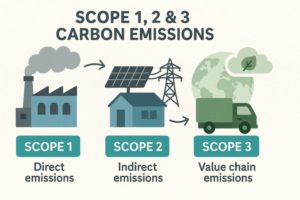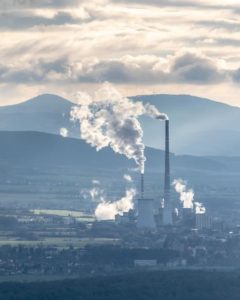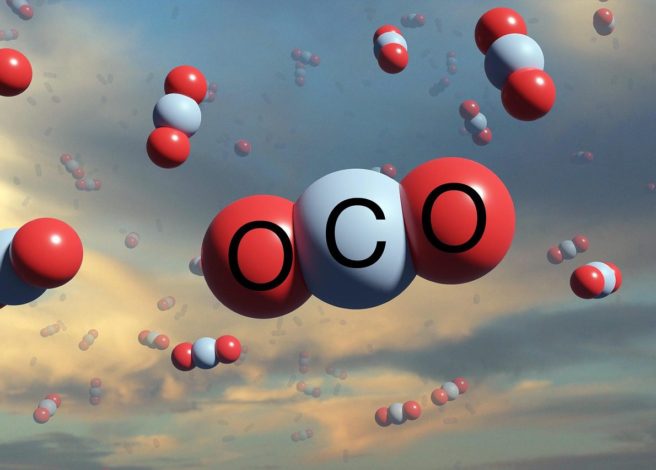At a Glance
- Understanding carbon footprints helps optimize packaging, tracking CO₂e from resin to disposal to identify reduction opportunities.
- Lightweight plastics lower emissions, often outperforming heavier alternatives in overall lifecycle impact.
- Food waste prevention is vital, as packaging that keeps food fresh significantly cuts embedded carbon.
- Data-driven decisions pay: using LCA tools and benchmarking leads to smarter, greener packaging choices.
This little blue dot we call home is sending us increasingly urgent signals that we must transform how we care for it. Understanding carbon footprints is essential for both the environment and businesses, especially as climate concerns grow.
This article explores key questions about carbon emissions, discusses their effects, and explains how food professionals can help reduce them. We’ll define what a carbon footprint is and share simple ways to help the planet while keeping profits safe.
What Is a Carbon Footprint?
It’s a fair question. There are a lot of buzzwords running amok in the discussion of sustainability. It’s important to know exactly what we’re talking about. A carbon footprint measures the total greenhouse gases (GHGs) released by a person, group, event, or product. This can happen directly or indirectly. It’s usually measured in metric tons of carbon dioxide equivalents (CO₂e). This includes greenhouse gases like methane (yes, the stuff from cows), nitrous oxide, and fluorinated gases. You can see these in the cloud at the top of emissions diagrams.
In the food industry, understanding carbon footprints involves calculating emissions from farm to fork. This includes everything from growing crops and processing food to packaging, transporting, cooling, cooking, and waste. The idea seems simple, but measuring and managing emissions is complex. It takes a methodical approach and knowledge of their sources.
The Three Scopes of Carbon Emissions

Imagine carbon emissions as a story divided into three chapters. Each chapter uncovers a unique part of your carbon journey. Let’s examine these scopes in more detail:
Scope 1 – Direct Emissions
These occur from sources owned or controlled by your organization. Food businesses have emissions from several sources.
These are:
- Company facilities
- Automation systems
- Company delivery trucks
- On-site power sources
- Refrigerant leaks from cooling units
In essence, these are the emissions that each business emits in its operations.
Scope 2 – Indirect Emissions
These emissions result from the generation of purchased energy. The food industry uses a lot of energy. It needs much electricity for food processing, refrigeration, and running facilities. Purchased energy often makes up a significant portion of a food business’s carbon footprint. You can look at these as the emissions given off by the power you need to run your operation.
Scope 3 – Other Emissions
This is where it gets interesting — it’s your “extended family” of emissions. This often makes up a big part of your carbon footprint. These are emissions you influence but don’t directly control. For food businesses, it covers all steps. It starts in the farm fields where ingredients are grown and ends with the packaging that wraps your products. Additionally, it covers what happens when customers throw away your containers. It also includes employee commutes, business trips, and even Zoom calls that replace in-person meetings. These emissions may seem far away but controlling them gives us great chances to be climate heroes (no Captain Planet required).
How Excess Carbon Affects Our Environment
 We must see why reducing carbon is urgent. It has major effects on the environment. GHGs trap heat in the atmosphere, causing global warming and leading to more severe and frequent weather events. These climate disruptions directly impact food production systems worldwide. Farmers are facing new challenges. They deal with changing growing seasons, long droughts, and unpredictable rainfall. These issues hurt crop yields and make planning harder.
We must see why reducing carbon is urgent. It has major effects on the environment. GHGs trap heat in the atmosphere, causing global warming and leading to more severe and frequent weather events. These climate disruptions directly impact food production systems worldwide. Farmers are facing new challenges. They deal with changing growing seasons, long droughts, and unpredictable rainfall. These issues hurt crop yields and make planning harder.
Oceans absorb about one-third of our carbon emissions. But they are becoming more acidic as CO₂ mixes with seawater. This chemical transformation threatens coral reefs, shellfish, and entire marine ecosystems.
Perhaps most alarming are the amplifying feedback loops now emerging in our climate system. As global temperatures go up, large areas of permafrost in the north are melting. This thawing releases carbon that has been stored for a long time. Make no mistake, this is a bad thing. The frozen ground holds twice the carbon of the entire atmosphere. Scientists warn that if it thaws, it could release 150 billion tons of carbon by 2100. These releases would speed up warming beyond our current forecasts. This would seriously impact global food systems, among many other catastrophes. It could disrupt growing areas, damage supply chains, and cause prices to swing wildly. Don’t panic, but it seems that what’s been on ice in the Arctic for thousands of years isn’t a vintage wine getting better with age — it’s more like a freezer full of forgotten leftovers that nobody wants defrosted.
The Business Case for Carbon Management in the Food Industry
Smart carbon management delivers real business value for food companies. Here’s how:
Carbon regulations continue to tighten globally, with many regions now implementing carbon taxes and cap-and-trade systems. Food businesses that proactively manage their emissions avoid penalties and stay ahead of regulatory curves.
The financial benefits extend beyond compliance. Energy efficiency measures that reduce carbon footprints typically cut operational costs as well, creating immediate savings alongside long-term environmental benefits.
 Market demand increasingly favors climate-conscious products. More consumers want foods that leave a smaller carbon footprint. This preference allows you to stand out in terms of your environmental performance. This trend appears especially strong in premium market segments.
Market demand increasingly favors climate-conscious products. More consumers want foods that leave a smaller carbon footprint. This preference allows you to stand out in terms of your environmental performance. This trend appears especially strong in premium market segments.
Investors recognize the value of environmental leadership. Companies that manage carbon well have been known to draw in more investment.
Authentic sustainability efforts significantly benefit brand reputation. Carbon reduction initiatives strengthen brand loyalty and market position in the food industry, where consumer trust directly affects purchasing decisions.
Finally, carbon management builds business resilience. Food companies can adapt better by managing climate risks in their operations and supply chains by understanding carbon footprints and taking action. This approach helps them tackle disruptions that increasingly threaten global agriculture and food systems.
Practical Steps for Food Industry Professionals
Food businesses can take meaningful action to reduce their carbon footprint. Begin by quantifying your emissions across all three scopes — you can’t manage what you don’t measure. Once you have baseline data, find the biggest emission sources in your operations and supply chain. This way, you can target your efforts for the most significant impact.
Preventing food waste addresses one of the industry’s largest emission sources while reducing costs. Nobody wants shrink — products that are thrown away due to spoilage, poor sales, or other losses. Look into packaging solutions that can give your products a longer shelf life and a better chance of being sold.
Work with suppliers to reduce emissions throughout your value chain, recognizing that collaborative approaches are essential for addressing Scope 3 emissions. Ensure your team understands carbon footprints and how their roles impact emissions through comprehensive training and engagement programs.
The Need for Better Education
 The food industry faces a significant knowledge gap about carbon emissions. Training employees, using simple measurement tools, and following industry guides help companies manage their carbon emissions better.
The food industry faces a significant knowledge gap about carbon emissions. Training employees, using simple measurement tools, and following industry guides help companies manage their carbon emissions better.
Clear communication about business benefits helps secure stakeholder buy-in. When food businesses take smart steps to reduce emissions, they set themselves up for lasting success. This action also supports solutions for climate change. Managing carbon well is both a responsible choice and crucial for long-term success.
Stepping in the Right Direction
Understanding carbon footprints matters deeply for all businesses, including food. Managing emissions across all three scopes delivers real benefits: lower costs, competitive advantages, and protection against climate disruptions. The food companies that will succeed tomorrow are taking action today. Our industry depends directly on a stable climate, making smart carbon management simply good business.
Earth is our only home (for now). Each step we take to reduce a carbon footprint supports the success of a company. It also protects the future of our food system and helps keep this little blue dot spinning happily.
Are you interested in learning more about sustainability? Visit the Inline Plastics Learning Center today. If you have questions, feel free to reach out. We’re here to help!

